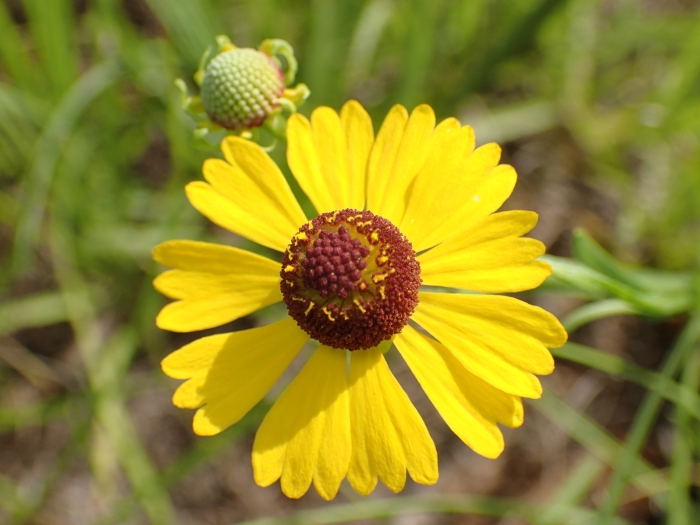Purple Sneezeweed
(Helenium flexuosum)
Purple Sneezeweed (Helenium flexuosum)
/
/

John P Friel
CC BY 4.0
Image By:
John P Friel
Recorded By:
Copyright:
CC BY 4.0
Copyright Notice:
Photo by: John P Friel | License Type: CC BY 4.0 | License URL: http://creativecommons.org/licenses/by/4.0/ | Rights Holder: John P Friel | Publisher: iNaturalist | Date Created: 2016-06-19T08:57:55-07:00 |



















































Estimated Native Range
Summary
Helenium flexuosum, commonly known as Purple Sneezeweed, is a deciduous perennial herb that is native to moist meadows, open woods, and along streams in the Eastern United States. It can reach up to 100 cm (40 inches) in height. This species is characterized by its branching array of flower heads, each bearing up to 700 disc florets that can be yellow or purple. The presence of ray florets varies, with some heads having 8-13 yellow, red, purple, or brown ray florets, adding to its ornamental value. The blooming period occurs in late summer to early fall, and the flowers are quite showy, attracting pollinators such as butterflies and bees.
Purple Sneezeweed is valued for its vibrant, long-lasting blooms and its ability to thrive in a range of soil moisture conditions. It is often used in wildflower gardens, meadow plantings, and as a border plant. While it prefers full sun, it can tolerate partial shade and is adaptable to various soil types, though it flourishes in well-drained soils. Gardeners should be aware that it can spread by rhizomes and self-seeding, potentially becoming aggressive in ideal conditions. To maintain its appearance and prevent excessive spreading, deadheading spent flowers and dividing clumps every few years are recommended.CC BY-SA 4.0
Purple Sneezeweed is valued for its vibrant, long-lasting blooms and its ability to thrive in a range of soil moisture conditions. It is often used in wildflower gardens, meadow plantings, and as a border plant. While it prefers full sun, it can tolerate partial shade and is adaptable to various soil types, though it flourishes in well-drained soils. Gardeners should be aware that it can spread by rhizomes and self-seeding, potentially becoming aggressive in ideal conditions. To maintain its appearance and prevent excessive spreading, deadheading spent flowers and dividing clumps every few years are recommended.CC BY-SA 4.0
Plant Description
- Plant Type: Herb
- Height: 2-3 feet
- Width: 1-2 feet
- Growth Rate: Moderate
- Flower Color: Yellow
- Flowering Season: Summer
- Leaf Retention: Deciduous
Growth Requirements
- Sun: Full Sun
- Water: Medium, High
- Drainage: Fast, Medium, Slow
Common Uses
Bee Garden, Bird Garden, Butterfly Garden, Deer Resistant, Drought Tolerant, Hummingbird Garden, Rabbit Resistant, Showy Flowers, Water Garden
Natural Habitat
Native to moist meadows, open woods, and along streams in the Eastern United States
Other Names
Common Names: Purplehead Sneezeweed , Naked-Flowered Sneezeweed , Purple-Headed Sneezeweed , Hélénie Nudiflore
Scientific Names: Helenium flexuosum , Helenium nudiflorum , Helenium floridanum , Helenium godfreyi , Helenium atropurpureum , Helenium brachypoda , Leptopoda brachypoda , Helenium seminariense , Heleniastrum nudiflorum , Heleniastrum parviflorum
GBIF Accepted Name: Helenium flexuosum Raf.